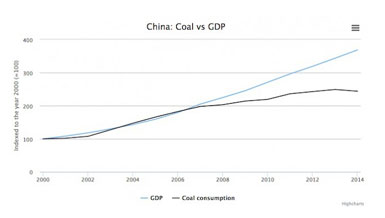Wow.
In a major setback for climate calculations, China quietly revealed it has been under-reporting carbon emissions since 2001, to the tune of 17%.
That increases China’s already colossal emissions by nearly a billion tons a year – equal to Germany’s total annual emissions, reports the NY Times. That’s a big number for a country that contributes 28% of global emissions.
While this certainly makes China’s promise to peak emissions by 2030 much more daunting, it also makes it more urgent.
"This helps to explain why China’s air quality is so poor, and that will make it easier to get national leaders to take this seriously," Yang Fuqiang, a former Chinese energy official, told the NY Times.
The gap mostly comes from small companies and factories in heavy industries, such as steel and cement, not power plants, and is highest in the most recent years. It was discovered during the 2013 census of the economy, but economists have long-questioned the accuracy of China’s data.
In the late 1990s, for example, the government ordered the dirtiest small coal plants to close, but many simply stopped reporting altogether.
Not only will China have to adjust its data on emissions and reassess its renewable energy goals, the data affects worldwide forecasts of climate change. Estimates are that China’s emissions have been 4-11% higher than reported.
Moving to Renewable Energy
Will China still peak emissions by 2030, but at much higher levels? Many people expect China’s emissions to peak by 2025 because overall, coal consumption is down for the first time over the past two years.

But China made no commitment after 2030 – after emissions peak, how long will it take for them to significantly decline? Decades, say many people.
The key is how quickly energy efficient and renewable technologies grow. The cheaper they are, the less attractive coal is.
"China has negative GDP growth if you factor in the healthcare costs of overreliance on coal," said Christopher Frei, secretary general of the World Energy Council.
Indeed, the pressure to significantly reduce air pollution as well as greenhouse gases means that China can’t continue relying on coal. By 2050, it’s feasible for China to get 60% of all energy from renewables and 85% of electricity, says the China National Renewable Energy Center.
After decades of growth-at-all-costs, last year, China announced it would prioritize the environment over the economy, and this year, it extended the ban on burning coal to include suburbs as well as the largest city centers. The goal is for 60% of cities to meet national pollution standards (three do now) by 2020.
One big question for scientists to answer is where the extra carbon gases went – most likely into the ocean. China’s gaff doesn’t affect the total world emissions – that is directly measured from the atmosphere.
Read our article, Coal Boom Finally Ends.

